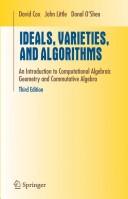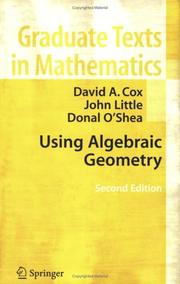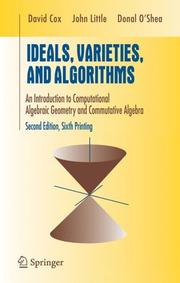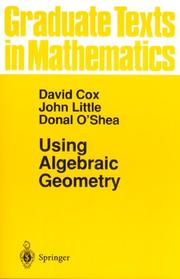| Listing 1 - 10 of 14 | << page >> |
Sort by
|
Book
ISBN: 9780141032382 Year: 2008 Publisher: London : Penguin books,
Abstract | Keywords | Export | Availability | Bookmark
 Loading...
Loading...Choose an application
- Reference Manager
- EndNote
- RefWorks (Direct export to RefWorks)
Algebraic topology. --- Mathematics --- Mathematicians --- Awards --- History. --- History. --- Poincaré, Henri, --- Perelman, Grigori,
Book
ISBN: 038797847X 354097847X 1475721838 1475721811 9780387978475 Year: 1992 Publisher: New York Springer
Abstract | Keywords | Export | Availability | Bookmark
 Loading...
Loading...Choose an application
- Reference Manager
- EndNote
- RefWorks (Direct export to RefWorks)
Algebraic geometry --- Computer. Automation --- Commutative algebra --- Geometry, Algebraic --- Algèbres commutatives --- Géométrie algébrique --- Data processing --- Informatique --- 512.77 --- -Geometry, Algebraic --- -#KVIV:BB --- Geometry --- Algebra --- Algebraic curves. Algebraic surfaces. Three-dimensional algebraic varieties --- Data processing. --- 512.77 Algebraic curves. Algebraic surfaces. Three-dimensional algebraic varieties --- #KVIV:BB --- Geometry, Algebraic - Data processing --- Commutative algebra - Data processing

ISBN: 9780387356518 Year: 2007 Publisher: New York, NY Springer
Abstract | Keywords | Export | Availability | Bookmark
 Loading...
Loading...Choose an application
- Reference Manager
- EndNote
- RefWorks (Direct export to RefWorks)
Mathematical logic --- Ordered algebraic structures --- Geometry --- Mathematical control systems --- Computer. Automation --- algebra --- landmeetkunde --- wiskunde --- logica
Book
ISSN: 01726056 ISBN: 9783319167213 3319167200 9783319167206 3319167219 Year: 2015 Publisher: Cham : Springer International Publishing : Imprint: Springer,
Abstract | Keywords | Export | Availability | Bookmark
 Loading...
Loading...Choose an application
- Reference Manager
- EndNote
- RefWorks (Direct export to RefWorks)
This text covers topics in algebraic geometry and commutative algebra with a strong perspective toward practical and computational aspects. The first four chapters form the core of the book. A comprehensive chart in the preface illustrates a variety of ways to proceed with the material once these chapters are covered. In addition to the fundamentals of algebraic geometry—the elimination theorem, the extension theorem, the closure theorem, and the Nullstellensatz—this new edition incorporates several substantial changes, all of which are listed in the Preface. The largest revision incorporates a new chapter (ten), which presents some of the essentials of progress made over the last decades in computing Gröbner bases. The book also includes current computer algebra material in Appendix C and updated independent projects (Appendix D). The book may serve as a first or second course in undergraduate abstract algebra and, with some supplementation perhaps, for beginning graduate level courses in algebraic geometry or computational algebra. Prerequisites for the reader include linear algebra and a proof-oriented course. It is assumed that the reader has access to a computer algebra system. Appendix C describes features of Maple™, Mathematica®, and Sage, as well as other systems that are most relevant to the text. Pseudocode is used in the text; Appendix B carefully describes the pseudocode used. From the reviews of previous editions: “…The book gives an introduction to Buchberger’s algorithm with applications to syzygies, Hilbert polynomials, primary decompositions. There is an introduction to classical algebraic geometry with applications to the ideal membership problem, solving polynomial equations, and elimination theory. …The book is well-written. …The reviewer is sure that it will be an excellent guide to introduce further undergraduates in the algorithmic aspect of commutative algebra and algebraic geometry.” —Peter Schenzel, zbMATH, 2007 “I consider the book to be wonderful. ... The exposition is very clear, there are many helpful pictures, and there are a great many instructive exercises, some quite challenging ... offers the heart and soul of modern commutative and algebraic geometry.” —The American Mathematical Monthly.
Mathematics. --- Algebraic Geometry. --- Commutative Rings and Algebras. --- Mathematical Logic and Foundations. --- Mathematical Software. --- Geometry, algebraic. --- Algebra. --- Computer software. --- Logic, Symbolic and mathematical. --- Mathématiques --- Algèbre --- Logiciels --- Logique symbolique et mathématique --- Mathematics --- Physical Sciences & Mathematics --- Geometry --- Algebraic geometry. --- Commutative algebra. --- Commutative rings. --- Mathematical logic. --- Geometry, Algebraic --- Commutative algebra --- Data processing --- Algebra of logic --- Logic, Universal --- Mathematical logic --- Symbolic and mathematical logic --- Symbolic logic --- Algebra, Abstract --- Metamathematics --- Set theory --- Syllogism --- Mathematical analysis --- Algebraic geometry --- Software, Computer --- Computer systems --- Data processing. --- Rings (Algebra) --- Algebra --- Ordered algebraic structures --- Mathematical control systems --- Computer architecture. Operating systems --- Computer. Automation --- Geometry, Algebraic - Data processing --- Commutative algebra - Data processing

ISBN: 0387207066 0387207333 1489987479 0387271058 Year: 2005 Volume: 185 Publisher: New York, NY : Springer New York : Imprint: Springer,
Abstract | Keywords | Export | Availability | Bookmark
 Loading...
Loading...Choose an application
- Reference Manager
- EndNote
- RefWorks (Direct export to RefWorks)
In recent years, the discovery of new algorithms for dealing with polynomial equations, coupled with their implementation on fast inexpensive computers, has sparked a minor revolution in the study and practice of algebraic geometry. These algorithmic methods have also given rise to some exciting new applications of algebraic geometry. This book illustrates the many uses of algebraic geometry, highlighting some of the more recent applications of Gröbner bases and resultants. The book is written for nonspecialists and for readers with a diverse range of backgrounds. It assumes knowledge of the material covered in a standard undergraduate course in abstract algebra, and it would help to have some previous exposure to Gröbner bases. The book does not assume the reader is familiar with more advanced concepts such as modules. For the new edition, the authors have added a unified discussion of how matrices can be used to specify monomial orders; a revised presentation of the Mora normal form algorithm; two sections discussing the Gröbner fan of an ideal and the Gröbner Walk basis conversion algorithm; and a new chapter on the theory of order domains, associated codes, and the Berlekamp-Massey-Sakata decoding algorithm. They have also updated the references, improved some of the proofs, and corrected typographical errors. David Cox is Professor of Mathematics at Amherst College. John Little is Professor of Mathematics at College of the Holy Cross. Dona l O’Shea is the Elizabeth T. Kennan Professor of Mathematics and Dean of Faculty at Mt. Holyoke College. These authors also co-wrote the immensely successful book, Ideals, Varieties, and Algorithms.
Geometry, Algebraic. --- Géométrie algébrique --- Geometry, Algebraic --- Geometry --- Mathematics --- Physical Sciences & Mathematics --- Géométrie algébrique --- EPUB-LIV-FT LIVMATHE SPRINGER-B --- Algebraic geometry --- Mathematics. --- Computer science --- Algebraic geometry. --- Algorithms. --- Algebraic Geometry. --- Symbolic and Algebraic Manipulation. --- Geometry, algebraic. --- Algebra --- Data processing. --- Algorism --- Arithmetic --- Foundations --- Computer science—Mathematics. --- Computer mathematics --- Electronic data processing

ISBN: 0387946802 1475726953 1475726937 9780387946801 Year: 1997 Publisher: New York : Springer,
Abstract | Keywords | Export | Availability | Bookmark
 Loading...
Loading...Choose an application
- Reference Manager
- EndNote
- RefWorks (Direct export to RefWorks)
Algebraic Geometry is the study of systems of polynomial equations in one or more variables, asking such questions as: Does the system have finitely many solutions, and if so how can one find them? And if there are infinitely many solutions, how can they be described and manipulated? The solutions of a system of polynomial equations form a geometric object called a variety; the corresponding algebraic object is an ideal. There is a close relationship between ideals and varieties which reveals the intimate link between algebra and geometry. Written at a level appropriate to undergraduates, this book covers such topics as the Hilbert Basis Theorem, the Nullstellensatz, invariant theory, projective geometry, and dimension theory. The algorithms to answer questions such as those posed above are an important part of algebraic geometry. This book bases its discussion of algorithms on a generalization of the division algorithm for polynomials in one variable that was only discovered in the 1960's. Although the algorithmic roots of algebraic geometry are old, the computational aspects were neglected earlier in this century. This has changed in recent years, and new algorithms, coupled with the power of fast computers, have let to some interesting applications, for example in robotics and in geometric theorem proving. In preparing a new edition of Ideals, Varieties and Algorithms the authors present an improved proof of the Buchberger Criterion as well as a proof of Bezout's Theorem. Appendix C contains a new section on Axiom and an update about Maple , Mathematica and REDUCE.
Geometry, Algebraic --- Commutative algebra --- Data processing --- Algebraic geometry --- Algèbres commutatives --- Géométrie algébrique --- Algèbres commutatives --- Géométrie algébrique --- Computer. Automation --- Informatique --- Mathematical logic. --- Mathematical Logic and Foundations. --- Algebra of logic --- Logic, Universal --- Mathematical logic --- Symbolic and mathematical logic --- Symbolic logic --- Mathematics --- Algebra, Abstract --- Metamathematics --- Set theory --- Syllogism --- Geometry, Algebraic - Data processing --- Commutative algebra - Data processing --- Géométrie algébrique. --- Algorithms --- Algorithmes. --- Algèbres commutatives.

ISBN: 0387984925 0387984879 1475769113 9780387984926 Year: 1998 Volume: 185 Publisher: New York (N.Y.) : Springer,
Abstract | Keywords | Export | Availability | Bookmark
 Loading...
Loading...Choose an application
- Reference Manager
- EndNote
- RefWorks (Direct export to RefWorks)
In recent years, the discovery of new algorithms for dealing with polynomial equations, coupled with their implementation on fast inexpensive computers, has sparked a minor revolution in the study and practice of algebraic geometry. These algorithmic methods have also given rise to some exciting new applications of algebraic geometry. This book illustrates the many uses of algebraic geometry, highlighting some of the more recent applications of Gr"obner bases and resultants. In order to do this, the authors provide an introduction to some algebraic objects and techniques which are more advanced than one typically encounters in a first course, but nonetheless of great utility. The book is written for nonspecialists and for readers with a diverse range of backgrounds. It assumes knowledge of the material covered in a standard undergraduate course in abstract algebra, and it would help to have some previous exposure to Gr"obner bases. The book does not assume the reader is familiar with more advanced concepts such as modules.
Geometry, Algebraic --- Geometry, Algebraic. --- 512.7 --- 512.7 Algebraic geometry. Commutative rings and algebras --- Algebraic geometry. Commutative rings and algebras --- Algebraic geometry --- Geometry --- Algebraic geometry. --- Combinatorics. --- Algebraic Geometry. --- Combinatorics --- Algebra --- Mathematical analysis

ISBN: 0387356517 Year: 2012 Publisher: New York, New York : Springer,
Abstract | Keywords | Export | Availability | Bookmark
 Loading...
Loading...Choose an application
- Reference Manager
- EndNote
- RefWorks (Direct export to RefWorks)
Algebraic Geometry is the study of systems of polynomial equations in one or more variables, asking such questions as: Does the system have finitely many solutions, and if so how can one find them? And if there are infinitely many solutions, how can they be described and manipulated? The solutions of a system of polynomial equations form a geometric object called a variety; the corresponding algebraic object is an ideal. There is a close relationship between ideals and varieties which reveals the intimate link between algebra and geometry. Written at a level appropriate to undergraduates, this book covers such topics as the Hilbert Basis Theorem, the Nullstellensatz, invariant theory, projective geometry, and dimension theory. The algorithms to answer questions such as those posed above are an important part of algebraic geometry. Although the algorithmic roots of algebraic geometry are old, it is only in the last forty years that computational methods have regained their earlier prominence. New algorithms, coupled with the power of fast computers, have led to both theoretical advances and interesting applications, for example in robotics and in geometric theorem proving. In addition to enhancing the text of the second edition, with over 200 pages reflecting changes to enhance clarity and correctness, this third edition of Ideals, Varieties and Algorithms includes: A significantly updated section on Maple in Appendix C Updated information on AXIOM, CoCoA, Macaulay 2, Magma, Mathematica and SINGULAR A shorter proof of the Extension Theorem presented in Section 6 of Chapter 3 From the 2nd Edition: "I consider the book to be wonderful. ... The exposition is very clear, there are many helpful pictures, and there are a great many instructive exercises, some quite challenging ... offers the heart and soul of modern commutative and algebraic geometry." -The American Mathematical Monthly.
Geometry, Algebraic --- Commutative algebra --- Data processing. --- Algebra --- Algebraic geometry --- Geometry --- Geometry, algebraic. --- Algebra. --- Logic, Symbolic and mathematical. --- Computer software. --- Algebraic Geometry. --- Commutative Rings and Algebras. --- Mathematical Logic and Foundations. --- Mathematical Software. --- Software, Computer --- Computer systems --- Algebra of logic --- Logic, Universal --- Mathematical logic --- Symbolic and mathematical logic --- Symbolic logic --- Mathematics --- Algebra, Abstract --- Metamathematics --- Set theory --- Syllogism --- Mathematical analysis

ISBN: 0387356509 1441922571 0387356517 9780387356501 9780387356518 Year: 2007 Publisher: New York : Springer,
Abstract | Keywords | Export | Availability | Bookmark
 Loading...
Loading...Choose an application
- Reference Manager
- EndNote
- RefWorks (Direct export to RefWorks)
Algebraic Geometry is the study of systems of polynomial equations in one or more variables, asking such questions as: Does the system have finitely many solutions, and if so how can one find them? And if there are infinitely many solutions, how can they be described and manipulated? The solutions of a system of polynomial equations form a geometric object called a variety; the corresponding algebraic object is an ideal. There is a close relationship between ideals and varieties which reveals the intimate link between algebra and geometry. Written at a level appropriate to undergraduates, this book covers such topics as the Hilbert Basis Theorem, the Nullstellensatz, invariant theory, projective geometry, and dimension theory. The algorithms to answer questions such as those posed above are an important part of algebraic geometry. Although the algorithmic roots of algebraic geometry are old, it is only in the last forty years that computational methods have regained their earlier prominence. New algorithms, coupled with the power of fast computers, have led to both theoretical advances and interesting applications, for example in robotics and in geometric theorem proving. In addition to enhancing the text of the second edition, with over 200 pages reflecting changes to enhance clarity and correctness, this third edition of Ideals, Varieties and Algorithms includes: A significantly updated section on Maple in Appendix C Updated information on AXIOM, CoCoA, Macaulay 2, Magma, Mathematica and SINGULAR A shorter proof of the Extension Theorem presented in Section 6 of Chapter 3 From the 2nd Edition: "I consider the book to be wonderful. ... The exposition is very clear, there are many helpful pictures, and there are a great many instructive exercises, some quite challenging ... offers the heart and soul of modern commutative and algebraic geometry." -The American Mathematical Monthly
Geometry, Algebraic --- Commutative algebra --- Géométrie algébrique --- Algèbres commutatives --- Data processing --- Informatique --- EPUB-LIV-FT LIVMATHE SPRINGER-B --- Algèbres commutatives --- Algorithmes --- Algorithms --- Algèbres commutatives. --- Algorithmes. --- Géométrie algébrique.

ISBN: 9780387356518 Year: 2007 Publisher: New York NY Springer New York Imprint Springer
Abstract | Keywords | Export | Availability | Bookmark
 Loading...
Loading...Choose an application
- Reference Manager
- EndNote
- RefWorks (Direct export to RefWorks)
Algebraic Geometry is the study of systems of polynomial equations in one or more variables, asking such questions as: Does the system have finitely many solutions, and if so how can one find them? And if there are infinitely many solutions, how can they be described and manipulated? The solutions of a system of polynomial equations form a geometric object called a variety; the corresponding algebraic object is an ideal. There is a close relationship between ideals and varieties which reveals the intimate link between algebra and geometry. Written at a level appropriate to undergraduates, this book covers such topics as the Hilbert Basis Theorem, the Nullstellensatz, invariant theory, projective geometry, and dimension theory. The algorithms to answer questions such as those posed above are an important part of algebraic geometry. Although the algorithmic roots of algebraic geometry are old, it is only in the last forty years that computational methods have regained their earlier prominence. New algorithms, coupled with the power of fast computers, have led to both theoretical advances and interesting applications, for example in robotics and in geometric theorem proving. In addition to enhancing the text of the second edition, with over 200 pages reflecting changes to enhance clarity and correctness, this third edition of Ideals, Varieties and Algorithms includes: A significantly updated section on Maple in Appendix C Updated information on AXIOM, CoCoA, Macaulay 2, Magma, Mathematica and SINGULAR A shorter proof of the Extension Theorem presented in Section 6 of Chapter 3 From the 2nd Edition: "I consider the book to be wonderful. ... The exposition is very clear, there are many helpful pictures, and there are a great many instructive exercises, some quite challenging ... offers the heart and soul of modern commutative and algebraic geometry." -The American Mathematical Monthly
Mathematical logic --- Ordered algebraic structures --- Geometry --- Mathematical control systems --- Computer. Automation --- algebra --- landmeetkunde --- wiskunde --- logica
| Listing 1 - 10 of 14 | << page >> |
Sort by
|

 Search
Search Feedback
Feedback About
About Help
Help News
News